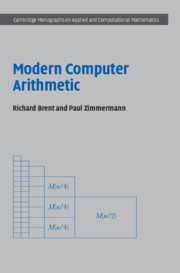4 - Elementary and special function evaluation
Published online by Cambridge University Press: 05 August 2012
Summary
Here we consider various applications of Newton's method, which can be used to compute reciprocals, square roots, and more generally algebraic and functional inverse functions. We then consider unrestricted algorithms for computing elementary and special functions. The algorithms of this chapter are presented at a higher level than in Chapter 3. A full and detailed analysis of one special function might be the subject of an entire chapter!
Introduction
This chapter is concerned with algorithms for computing elementary and special functions, although the methods apply more generally. First we consider Newton's method, which is useful for computing inverse functions. For example, if we have an algorithm for computing y = ln x, then Newton's method can be used to compute x = exp y (see §4.2.5). However, Newton's method has many other applications. In fact, we already mentioned Newton's method in Chapters 1–3, but here we consider it in more detail.
After considering Newton's method, we go on to consider various methods for computing elementary and special functions. These methods include power series (§4.4), asymptotic expansions (§4.5), continued fractions (§4.6), recurrence relations (§4.7), the arithmetic-geometric mean (§4.8), binary splitting (§4.9), and contour integration (§4.10). The methods that we consider are unrestricted in the sense that there is no restriction on the attainable precision – in particular, it is not limited to the precision of IEEE standard 32-bit or 64-bit floating-point arithmetic. Of course, this depends on the availability of a suitable software package for performing floating-point arithmetic on operands of arbitrary precision, as discussed in Chapter 3.
- Type
- Chapter
- Information
- Modern Computer Arithmetic , pp. 125 - 184Publisher: Cambridge University PressPrint publication year: 2010

